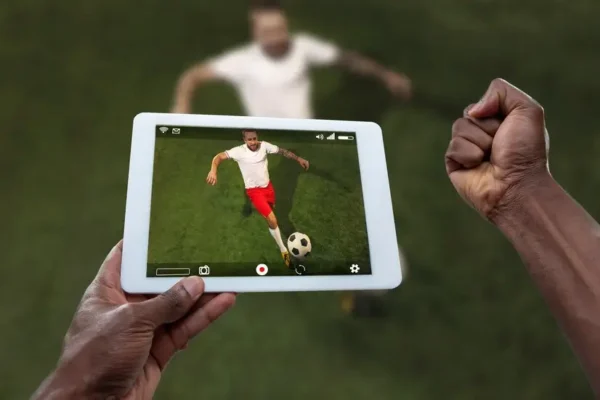Introduction
Within the last couple of years, the availability of largely use-friendly technology has transformed the way sports are streamed and consumed across the world. From once being something which could only be watched through television broadcasts and heard through radio coverage the consumer today enjoys the dynamic, interactive and personalized experience on an array of different platforms. Thanks to the progress made in streaming technology it has never been easier more accessible or more affordable for consumers to access sporting content.
Whether through live streaming service social networking site or mobile application fans can access favorite teams and athletes, literally and figuratively, anywhere and everywhere. This report discusses how easy technology is making sports streaming through five key areas accessibility, interactivity, personalization, monetization and fan engagement.
Increase Accessibility
The first and most important change that the technology has introduced in the sports streaming domain is accessibility to the global viewership. Replacing old means of watching from home with a traditional television set and live-streaming platforms as well as different mobile apps, opened up opportunities for any sports fan to watch a game on his smartphone, tablet or laptop. Users can stream live matches, highlights and analyses from such platforms as YouTube, Amazon Prime or special sports apps – ESPN+.
This accessibility has democratized the sports viewing to an extent, eradicating regional boundaries and allowing an audience from one corner of the globe to view live the broadcasts from another corner of the globe. Not to mention the ability of streaming services to provide on-demand viewing of games allows viewers a chance to catch what they may have missed this further increases convenience. Whether it is catching a match while moving about and following your favorite Premier League or seeing the NBA highlights on the way the average sports follower is no longer constrained by rigid broadcast schedules.
Interactivity
Another significant shift in sports streaming is interactivity which transforms the fan experience. This is not the generation of passively sitting and viewing, then sitting back to monitor as viewers do with earlier platforms but rather the one that engages them with live content in real-time. Live chat rooms and polls with social media integration on Twitch Facebook Live and Twitter provide a venue for fans to share their thoughts and reactions at plays in real-time with other fans watching the game.
It adds more communality to the view and fans can participate in the live discussion by putting up their predictions while others go a step ahead with Q&A with commentators and players. Additionally many at this moment have included AR and VR that make the viewer a part of the action. Through these technologies one is able to change angles of cameras take close-up shots of the players or even get the experience that one is in a game as a player.
Personalization
The most innovative ways that easy technology has changed the sporting aspect are through personalized views of the sports video. Algorithms and data analytics are applied on tailor-made content for the choices of individual users. A streaming platform stores data from user preference teams a specific form of sports, or players. These may then be recommended to an individual using personalized content. Some may have like game highlights, exclusive interviews or related events.
For example Netflix and YouTube employ an algorithm recommendation of content based on what a viewer has watched before. DAZN and Fubo TV have their customizable dashboards for sports, where users can set up alerts for upcoming matches hide all the other sports they’re not interested in, or just get live score updates. This kind of personalization does not only enhance the experience of a fan but also keeps him hooked on to content that matters the most to him.
Live Streaming Innovations
Development in streaming quality has allowed for the improvement in the broadcast of sports events. Now, pixelated or laggy streams are long gone. Now easy technology can offer HD even 4K Ultra HD live streaming providing crystal clear visuals that will make it even more beautiful to watch on the screen. YouTube and Twitch platforms now integrate HD and 4K for actual sports events with its streaming so as not to disappoint the fans who would want to see the best out of the event they’re watching.
Other innovations change the culture of capturing live events. For example, through a 360-degree camera, viewers can get a view of games as if they are sitting in the stadium. Companies such as NextVR are experimenting with virtual reality and 360-degree video streaming, hence making it possible for the viewer to experience the event just as they would in real life. At this point, fans can now view their favorite games from any angle or even go through a virtual tour of the stadium. This innovation has brought sports viewing a step closer to real life hence even more immersive and thrilling.
Monetization and Sponsorship
Easy technology also ushered in the availability of new revenue channels in sports streaming for equal benefiting of leagues, teams and creators of content. For one a broader audience for sports organizations has paved the way for further revenue generation because live streaming is readily available. For example there are such platforms like Twitch that enable viewers to pay subscription for accessing particular channels, and on YouTube the Super Chat feature allows viewers to highlight their messages during live streaming for a certain amount of money.
Digital ad spends and sponsorships are also a new aspect of sports streaming. More and more brands are focusing on online audience with personalized ad targeting that is based on the demographics and preferences of the viewers. Few streaming services have even introduced interactive ads that let viewers engage with content created by brands in real-time. Pay-per-view events and subscription models like ESPN+ or WWE Network open exclusive games and behind-the-scenes content to fans for higher revenue from teams and leagues.
Fan Engagement
Newer technologies have also birthed a sports influencer and content generator changing the very façade of fan engagement. The new means of connection between fans and athletes and commentators would be the platforms such as Instagram, TikTok and YouTube, considering how it has made things possible that couldn’t be thought of in any other way. As for the sports streaming these influencers now account for a more vital role. With behind-the-scenes access commentary and exclusive content created to build loyalty in the fans this largely represents a growing part of sports.
These have enabled sporting leagues and teams to acquire direct control over the presentation of their content, hence circumventing those traditional broadcasters and directly engaging with the fans. To name but a few athletes can at any time live stream their training sessions share certain moments with their fans and by these means engage with them through their social media accounts. It makes the relationship between the fan and an athlete or a team more personal and exciting as they get closer to the favorite athlete or team.
The Future of Sports Streaming
The future of sports streaming has even more potential with the continued advancement of easy technology. Because 5G promises faster and more reliable internet connections streams will flow smoothly hopefully at a better video quality. AI-produced highlights and camera systems will personalize the experience: delivered are tailored content and real-time updating basing on the fans’ preference.
There will also be a heightened use of virtual and augmented reality to make the live sport streaming more vivid. To give some context a fan can experience being in the arena while staying in his or her home. The ability to let fans know that streams are coming from the direct source may utilize block chain technology thus increasing transparency in the matter. Higher depths of fairness in compensation for athletes will also be guaranteed.
Conclusion
Easy technology has revolutionarily changed the way sports are streamed it is now more accessible more interactive and a whole lot more ‘me’. Fans can be anywhere in this world to watch a live event interact with other fans or have a highly personalized experience showing their preference. Innovations like 4K streaming, virtual reality and real-time social integration have evolved sports streaming into a dynamic immersive experience. With advance technology the future of the sports stream will be more innovative in terms of changing time with regard to fan experience. Essentially the efficiency has also transformed sports streaming as well as how peoples communicate and connect with each other while it makes a sport’s ecosystem fun and engaging.





